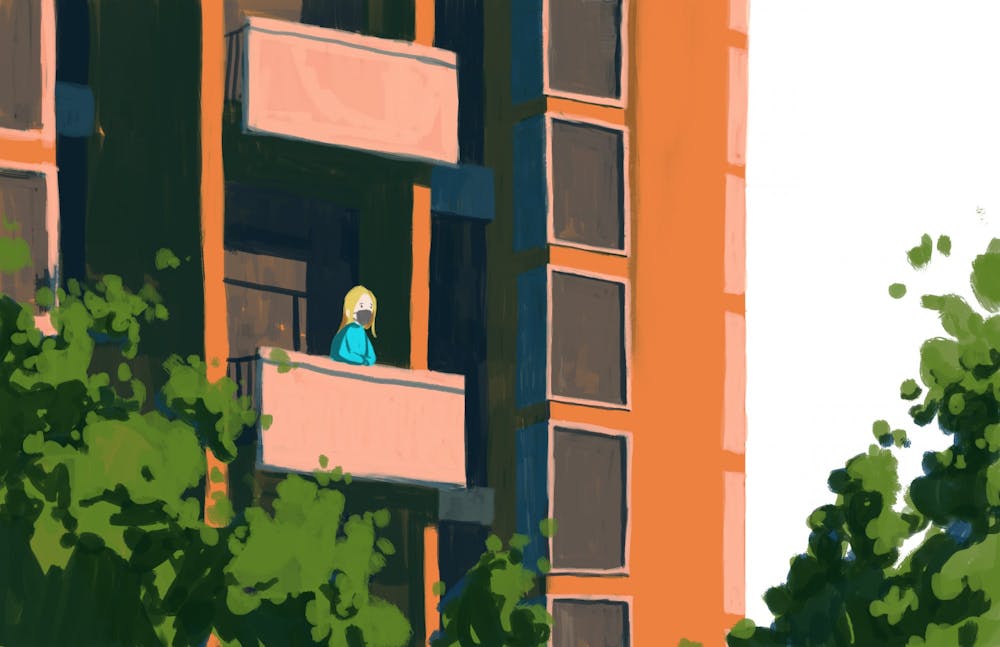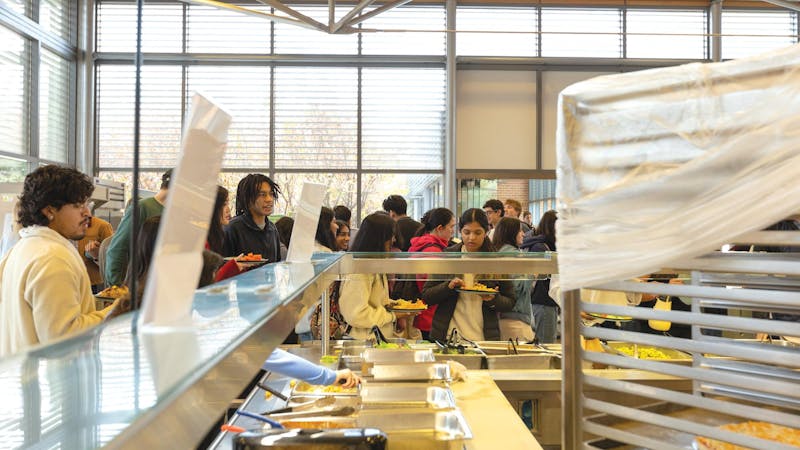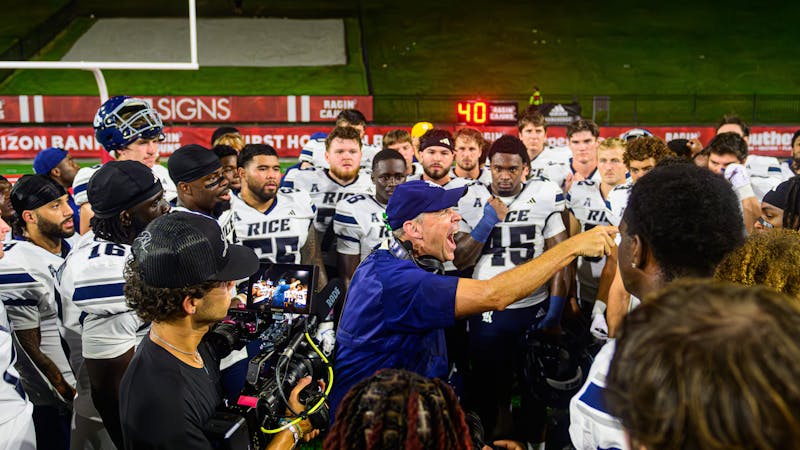Alone at Sid: Life in the isolation tower

The tower that used to house the Sid Richardson College community is quiet these days: hallways are bare and most floors are vacant. The only people living there are a handful of students from across the residential colleges, and they mostly keep to their rooms.
Amid the pandemic, Rice students with a positive COVID-19 test result or COVID-19-like symptoms must isolate either off campus or at the Sid building, according to Lisa Basgall, Rice Emergency Medical Services Director and Infection Control Group supervisor on Rice’s Crisis Management Team. The Thresher spoke with four students who have isolated at Sid, interviewed members of Housing and Dining and the Crisis Management Team and looked over dozens of screenshots of texts and emails between students and staff to find out what it’s like to isolate at Sid.
Since the semester started, numerous students have stayed at Sid, according to associate vice president of Housing and Dining Mark Ditman, who leads the H&D team that oversees isolation at Sid. The average occupancy this semester has been four or five students at a time, Ditman said, and the highest number of students isolating at Sid at one time has been ten. More on-campus students have stayed at Sid than off-campus students, according to Jerusha Kasch, director of Institutional Crisis Management.
Isolation housing at Sid falls under the responsibility of the Crisis Management Team and H&D. Led by Kasch, the Crisis Management Team oversees potential and confirmed COVID-19 cases and determines isolation status, she said, and coordinates with Student Health Services, REMS, Rice University Police Department, H&D and Facilities Engineering and Planning to oversee students isolating at Sid. According to Ditman, the Sid H&D team primarily tends to hotel-like duties, such as check-in and food delivery.
“We try to get to know the students and just make sure that nobody is in distress, or if they need somebody to talk to or need something delivered,” Ditman said. “I try to say to [students that are isolating] that, ‘Our job is to make this as tolerable as possible for you and your job is not to infect us.’”
Led by Ditman, the H&D team at Sid includes custodial staff member Gloria Arreola, Retail Dining Manager Norma Cardona and Senior Operations Manager of North Servery Derrix Norman. They have exclusive access to the building, Ditman said, working on site during business hours, seven days a week. After hours, REMS and RUPD are prepared to address students’ concerns, according to Ditman.
Moving to Sid
When Audrey Yao opened her COVID-19 test result email after dinner on Oct. 28, she found that she had tested positive for the virus. According to Yao, she had not received a phone call from a contact tracer. She said she contacted RUPD, who told her to call Crisis Management at 8 a.m., and the Texas Medical Center hospital of Houston Methodist, a provider of Rice’s COVID-19 tests, who told her to call back at 8 a.m.
“I was like, ‘Alright, am I only allowed to have a crisis during working hours? Is that what that means?’” Yao, a junior at Will Rice College, said. (Disclaimer: Audrey Yao is the Thresher's video editor.)
Chief of Police Clemente Rodriguez said that RUPD does not have test result information to provide students. Gale Smith, public relations manager at Houston Methodist, said the department that Yao called was probably not available at that time of night.
Kasch said it is possible for a delay between when test providers such as Houston Methodist or Baylor Genetics automatically post a student’s test results to the online portal MyChart, and when an employee of the provider calls Crisis Management and informs them of the positive case. This has occasionally caused delays of up to three hours between when students are emailed their results and when Crisis Management begins to contact trace them. If this happens, Kasch said students should call the Rice Community Information Center, which is in operation from 8 a.m. to 4 p.m. Monday through Friday according to the Return to Rice website.
According to Kasch, once Rice Crisis Management has received word that a student has had a positive result, they take multiple steps to reach that student, including calling, texting and emailing them, as well as reaching out to their residential college magister. Kasch said contact tracers are working all day, every day. The last batch of test results typically arrives from providers at around 8:30 p.m., and contact tracers work on any positive cases in the following hours.
After calling RUPD and Houston Methodist, Yao was able to get in touch with Anna Margaret Clyburn, Student Association president and member of the Crisis Management Team, who was able to contact Kasch on behalf of Yao, according to both Yao and Clyburn. Yao, who lives on campus, said that after this communication, someone from the Crisis Management Team contacted her and told her that she needed to stay at Sid for 10 days and that they had attempted to call her at 8 p.m.
Yao said her ID did not work to open Sid’s door as the Crisis Management Team told her it would when she arrived there at around 11 p.m., so she waited half an hour for RUPD to let her in.
“Moving there was the most frustrating part because [during] the first couple days at Sid my primary emotion was frustration and anger,” Yao said. “That first night sucked. Everything else I was like, ‘Okay, this is fine.’”
Kasch said that such a door issue was likely a human error: It’s possible the staff member managing building access did not receive the information or inputted it incorrectly, or there was a delay in granting access. She said that sort of error is uncommon.
On Oct. 15, Louis Alvares woke up to missed calls from a Crisis Management Team contact tracer, he said. While Alvares, a Martel College senior, was asymptomatic, he said a contact tracer told him that his test result from the day before was positive and that he had to leave his suite at Martel.
“I had about an hour to pack my things up so I had to skip my class that day. And then I was zooming on the golf cart to Sid with my stuff,” Alvares said. “It wasn’t the most discreet, but you know, things had to be done … Before I came to campus I knew that’s what I was signing up for.”
Kasch said the Crisis Management Team tries to determine the best mode of travel to Sid based on a student’s situation and the available options at the time. Students might walk, be picked up in golf carts or ride a “symptomatic bus,” according to Kasch.
On Oct. 1, Noah Crumrine submitted a health report and a symptomatic test request and then got tested the same day, he said. According to Crumrine, a Will Rice College senior living off campus, a contact tracer soon called him and told him he had to move to Sid, which the Thresher was unable to confirm.
Crumrine said he was unprepared for the move because he had expected to be told to remain at his house.
“I didn’t think there was any way that they were going to bring me from off campus to on campus,” Crumrine said. “But [my contact tracer asked] me about the layout of my house and whether or not I share a bathroom with my housemates, and then they kind of just decided on the fly that I wouldn’t be able to quarantine from them and that the only solution was to bring me to Sid.”
Basgall and Kasch said the Crisis Management Team suggests, but does not mandate, that off-campus students who must isolate move to Sid.
“We’re not going to require [students to isolate at] any one particular place or another,” Basgall said. “We definitely recommend isolation housing at Sid. It’s a comfortable place to be, and that’s a good and safe choice.”
Crumrine said the contact tracer told him to pack a bag and wait to be notified about how he would travel to Sid. A few hours after his initial call with the contact tracer, he said he carried his belongings from his off-campus residence to the edge of the Rice campus, where a golf cart picked him up and took him to Sid.
Crumrine brought a keyboard and monitor for his coding homework, as students won’t be able to complete some of their assignments if they don’t have the necessary items with them at Sid, he said. Yao said she had packed thoroughly — bringing her laptop, external monitor, desk lamp, three blankets and a pillow — because the stay at Sid is 10 or more days of trying to be a normal student.
“I needed to bring all of my school stuff,” Yao said. “I remember when [the Crisis Management Team] called me: ‘Oh, pack as if you’re going to a hotel for 10 days.’ That is unrealistic because when you normally go to a hotel, you’re on vacation.”
Living conditions
Each student at Sid has their own suite, according to Basgall. Alvares said he had access to a bedroom and a bathroom in his suite double. Alvares, Crumrine and Yao said their rooms at Sid were stocked with supplies including bottled water, bed linens and a microwave.
Ditman said that the rooms at Sid do not have their own thermostats. Yao said that if she had not brought three of her own blankets, she would have had a miserable first night because her room was too cold. This issue was resolved after the H&D team at Sid brought her a space heater, Yao said, but she found the bedding provided to be poor quality.
“I brought my own bedding and I’m really glad that I did, because the bedding that they give you there is the cheap tan hotel blanket and a couple sheets and a really sad pillow,” Yao said.
Ditman said the bedding at Sid is the same bedding provided to summer conference programs. He said that students are informed that they can bring items like pillows from their residences.
According to Ditman, New Sid construction usually takes place between 7 a.m. and 4 p.m. Mondays to Saturdays, and very rarely on Sundays, although the schedule varies depending on the contractor’s objectives.
Alvares said that the morning after his first night at Sid, he was awakened early by the noise of construction and had to request ear plugs. Crumrine said that the construction began around 6:30 a.m. most days during his stay at Sid. He has always had difficulty sleeping with noise, he said, so he placed his mattress on the floor in the walk-in closet to improve sound insulation.
“[The noise] made it not only more difficult to recover from the sickness that I did have, but it also made it almost impossible to get any work done,” Crumrine said.
Meals are delivered to students two times a day, according to Ditman. Lunch is delivered at lunchtime; dinner and breakfast are delivered in the evening. While meals mostly come from the serveries, Ditman said that he and Norman have tried to add variety with other food, such as Ben and Jerry’s ice cream, Cane’s chicken strips and barbecue prepared by Norman.
Crumrine said he felt that the pre-packaged foods he received for breakfast, such as cookies, Pop-Tarts and PB&J Uncrustables, were not ideal for recovery from illness, although he appreciated the nighttime delivery of breakfast so that staff do not wake students the following morning. According to Ditman, students’ breakfasts can also include oatmeal, yogurt and fruit, and he cooks hot breakfasts for them on Fridays.
The meals were comparable to other servery dishes, according to Yao.
“It’s about as good or as bad as you think servery food is — not spectacular but comparatively it’s the same,” Yao said. “It just arrives [at the] door a little bit cold, so you throw it in the microwave and it’s fine.”
Although students must remain on their respective floors during their stay at Sid (except when doing laundry, which they can do in the former RA apartment on the second floor) they are allowed to leave their room to visit the lobby and balcony when there are no staff present, according to Ditman. Yao said she decided to remain in her room for most of her stay after she got locked out twice on the second day.
Alvares said there wasn’t much he could do in the empty lobby, where he didn’t see any other students, but he took advantage of the balcony’s outdoor space.
“I was out there [on the balcony] for half an hour watching the sunset, trying to stay positive and everything — no pun intended,” Alvares said.
Crumrine said he would leave his room only to take out the trash.
“There are two times during the day when you’re allowed to go out to the balconies. I think the only reason that they’d be willing to do that is for mental health,” Crumrine said. “But there was no way I was gonna do that considering the fact that there are people who are testing positive at Sid.”
Aside from one violation of the remain-on-your-floor rule early in the semester, there have been no major issues at Sid regarding conduct, according to Ditman.
“It’s great that we don’t feel like we have to have somebody in residence to monitor behavior,” Ditman said. “That would not speak well of the student body, and I haven’t seen any indication at all that it would be necessary.”
The H&D residential staff were gracious hosts, Alvares, Crumrine and Yao said. Alvares said the H&D team delivered Chef Roger Elkhouri’s cinnamon rolls and food that he asked for. Crumrine said Ditman brought him the antibiotics his friend dropped off.
“H&D did everything they could to make it a pleasant stay,” Alvares said.
Alvares said the Crisis Management Team staff who contacted him were friendly and helpful as well.
Check-ins and communication
Kasch said that each student in isolation is assigned to a contact tracer from the Crisis Management Team who is in communication with the student every day. Alvares, Crumrine and Yao said they had daily health checks with their contact tracer over text and occasional telemedicine appointments with representatives from Student Health Services.
Maia Helterbrand, a Will Rice College junior and Yao’s roommate who isolated at Sid after showing symptoms, said her televisits with Student Health Services were usually very quick.
“You schedule it and then like an hour or two later, you have an appointment and it’d be for a short amount of time, basically going over if you have symptoms or not, how you’re doing, and I would ask what’s the game plan. And [they said], oh we're going to give you another test,” Helterbrand said. “So it was great.”
According to Basgall, the testing provider goes to Sid to administer any necessary COVID-19 tests for the students there. Helterbrand said she was tested right outside her door.
Alvares, Crumrine, Helterbrand and Yao said they perceived a lack of communication between the teams managing Sid. Crumrine and Helterbrand said they especially noticed communication issues between Crisis Management and Student Health Services.
“It seems that Rice Crisis Management and Student Health Services are a bit disjointed and there seems to be a bit of a delay in between their communication and decision-making with one another,” Helterbrand said. “For example, when [I underwent] the symptomatic test, [student health] told me they were going to wait for the results, and Rice Crisis Management independently told me they were going to move me straight away.”
Kasch said that Student Health Services is an operation separate from Crisis Management, but they coordinate with each other daily. She said there is no lack of communication between them, but students may feel confused when there is a difference of opinion between the physician and the Crisis Management Team.
“[A perception of miscommunication] is Student Health Services not understanding the protocol and saying things before working with Crisis Management,” Kasch said. “Occasionally someone is going to say the wrong thing, and we just have to help students understand that this person might not have been clear about the standard … but the team works very hard to get it straight on a regular basis.”
Alvares, Helterbrand and Yao said they would sometimes check in with a counselor from the Wellbeing Center over text. The Student Wellbeing Office reaches out to students in isolation by calling them at the beginning of their isolation period and offers to check on them by phone or text, according to Agnes Ho, director of the Student Wellbeing Office.
Crumrine and Yao said their professors granted their requests for extensions on their assignments. Helterbrand said she appreciated her professor’s leniency because she was unfocused and unable to be very productive while isolated.
Being alone
Helterbrand and Yao said the isolation at Sid was not very different from their experiences at home in the spring and summer.
“I don’t think I suffered any negative consequences from being in isolation just because I spend a lot of alone time anyways,” Yao said. “That’s just who I am as a person.”
Crumrine said that he was never fully comfortable with the move to Sid and that he didn’t feel like talking to his peers during his stay.
“I still was sick and I was stressed and tired, and I kinda just wanted to sleep the whole time,” Crumrine said.
Alvares said that maintaining a social life and combating boredom were the hardest aspects of isolation. He called friends and family from home, he said, and engaged in online events like a study session with his 2020 Orientation Week group, a yoga night and his class meetings.
“I’d say I’m a little lucky to have a pretty good support group because if not, it probably would suck even more to be totally isolated,” Alvares said.
Nonetheless, Alvares said that the lack of in-person interaction for 10 days took a toll on him and that he was anxious to leave.
“The first one to two to three days you’re like, ‘I think I can do this,’ and then by day six or seven you’re like, ‘Holy crap. I am literally in the same room all day,’” Alvares said. “I was trying to find ways to stay upbeat and not feel down. Midnight hit [on the day of my release] and I was like, ‘Please pick me up.”
Out of Sid
While the Centers for Disease Control and Prevention guidelines inform Rice policies, there is no one set of conditions that automatically prompts release from isolation at Sid, according to Basgall. In general, students who have tested positive must stay at Sid for 10 days, according to Kasch. Symptomatic students undergo COVID-19 testing and evaluation by Student Health Services. Before Crisis Management releases the student from isolation, they must have received two negative COVID-19 tests and the physician must have decided that the student is not suspicious for COVID-19, Basgall and Kasch said.
“The physician really drives the [health care] plan,” Basgall said. “Until the physician is certain, they’re not going to say, ‘You should leave isolation now.’”
Kasch said that after Student Health Services confirms a student’s clearance and two negative tests, the Crisis Management Team contacts the student and informs them about their release. Ditman said that aside from leaving the room key in the door, there is no check-out procedure for students approved to leave Sid.
Alvares said the process of leaving Sid was quite simple, which Kasch and Ditman confirmed.
“[Leaving is] literally the simplest thing in the world,” Alvares said. “You just leave the key on the door and you leave the building.”
Alvares said that he can’t complain about his experience at Sid, given the situation. He is happy to be back at his college now, though.
Crumrine said he felt like he stayed at Sid longer than he should have. He was told to move to Sid before he had a test done, he said, and was told by Crisis Management that he needed two negative test results to be released. Eventually, he got two negative test results in a row without testing positive, he said.
Crumrine said he was fairly resigned to the isolation process but would have wanted to receive his COVID-19 test result before moving to Sid, particularly because he had a difficult time recovering and studying there.
“After I’d already been at Sid for a while, I started to feel like the whole process would have been more logical if I had actually received a test result before I had moved to Sid,” Crumrine said. “I get sick so often that it’s like a meme among me and my friends.”
Helterbrand said that on Nov. 3, Student Health Services told her she could leave after she tested negative twice. That evening, she received notice from the Crisis Management Team that she could leave, she said, and the following day she returned to Will Rice, where she and her suitemates continued to quarantine because Yao, their roommate, had tested positive.
Helterbrand said she preferred quarantine in her dorm over isolation at Sid.
“I think there are pros and cons,” Helterbrand said. “Like with Sid, you can go outside on the balconies and do laundry in the RA apartment, but [in my suite at Will Rice], I have other people and so it’s less lonely, definitely.”
According to Ditman, his H&D team has received overwhelmingly positive responses from students and parents. He said that his team welcomes feedback and hopes that unhappy students reach out to them.
“I don’t think anybody’s left upset. If they have, I’m not aware of it,” Ditman said. “But you know it’s a tough deal, if you think about it, to be by yourself — you can only spend so much time on your devices,” Ditman said. “We understand that this is a challenging time for students, and their families, to go through.”
Kasch said she doesn’t think the Crisis Management Team gets enough credit for the work they do.
“Sometimes it's really hurtful for students to be very critical about this process because honestly, we've had a team that does not count their time off in days anymore. They count their time off in hours. They work seven days a week, all day, every day,” she said. “[They] have worked nonstop for the benefit of this Rice community, and I don't think they get enough credit for that.”
Basgall and Ditman said that Old Sid will continue to serve as isolation housing in the spring semester.
Features Editor Ella Feldman contributed to this reporting.
More from The Rice Thresher

Over 1,000 students petition against new meal plan
When Konstantin Savvon opened the Housing and Dining email announcing the new unlimited meal plan, he was instantly concerned about the impact on off-campus students like himself.

Rice football wins season opener under new coach
For the first time since 2018, Rice football opened its season with a victory. Scott Abell was soaked with yellow Powerade following a 14-12 win on the road Saturday against the University of Louisiana at Lafayette, which won 10 games and made it to the Sun Belt Conference championship last season.

Acting like an athlete: Rice basketball alum takes on Broadway
Underneath Chadd Alexander’s Broadway costume, there’s ankle tape and wrist braces — same protective gear he wore as a walk-on basketball player at Rice, though now he’s performing eight shows a week in the ensemble of “Harry Potter and the Cursed Child” instead of running conditioning drills in Tudor Fieldhouse.

Please note All comments are eligible for publication by The Rice Thresher.